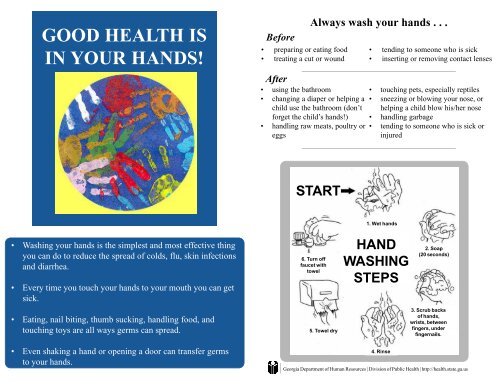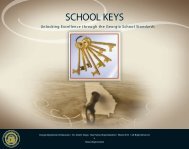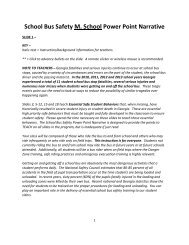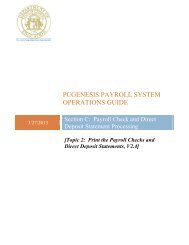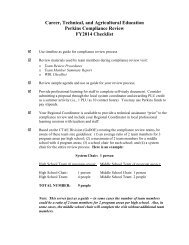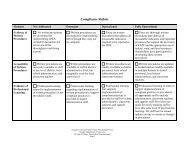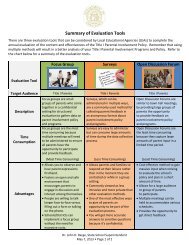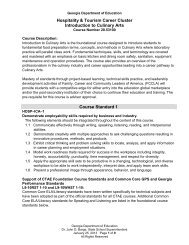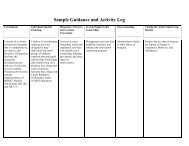Children's Handwashing Chart and Rules - Georgia Department of ...
Children's Handwashing Chart and Rules - Georgia Department of ...
Children's Handwashing Chart and Rules - Georgia Department of ...
You also want an ePaper? Increase the reach of your titles
YUMPU automatically turns print PDFs into web optimized ePapers that Google loves.
GOOD HEALTH IS<br />
IN YOUR HANDS!<br />
Before<br />
• preparing or eating food<br />
• treating a cut or wound<br />
After<br />
Always wash your h<strong>and</strong>s . . .<br />
• using the bathroom<br />
• changing a diaper or helping a<br />
child use the bathroom (don’t<br />
forget the child’s h<strong>and</strong>s!)<br />
• h<strong>and</strong>ling raw meats, poultry or<br />
eggs<br />
• tending to someone who is sick<br />
• inserting or removing contact lenses<br />
• touching pets, especially reptiles<br />
• sneezing or blowing your nose, or<br />
helping a child blow his/her nose<br />
• h<strong>and</strong>ling garbage<br />
• tending to someone who is sick or<br />
injured<br />
START<br />
• Washing your h<strong>and</strong>s is the simplest <strong>and</strong> most effective thing<br />
you can do to reduce the spread <strong>of</strong> colds, flu, skin infections<br />
<strong>and</strong> diarrhea.<br />
• Every time you touch your h<strong>and</strong>s to your mouth you can get<br />
sick.<br />
• Eating, nail biting, thumb sucking, h<strong>and</strong>ling food, <strong>and</strong><br />
touching toys are all ways germs can spread.<br />
6. Turn <strong>of</strong>f<br />
faucet with<br />
towel<br />
5. Towel dry<br />
1. Wet h<strong>and</strong>s<br />
HAND<br />
WASHING<br />
STEPS<br />
2. Soap<br />
(20 seconds)<br />
3. Scrub backs<br />
<strong>of</strong> h<strong>and</strong>s,<br />
wrists, between<br />
fingers, under<br />
fingernails.<br />
• Even shaking a h<strong>and</strong> or opening a door can transfer germs<br />
to your h<strong>and</strong>s.<br />
4. Rinse<br />
<strong>Georgia</strong> <strong>Department</strong> <strong>of</strong> Human Resources | Division <strong>of</strong> Public Health | http://health.state.ga.us
Children’s <strong>H<strong>and</strong>washing</strong> <strong>Rules</strong><br />
(Effective 8-25-10)<br />
Children’s h<strong>and</strong>s shall be washed with liquid soap <strong>and</strong> warm running water as follows:<br />
Immediately upon arrival for care<br />
When moving from one child care group to another<br />
Upon re-entering the child care area after outside play<br />
Before <strong>and</strong> after:<br />
eating meals <strong>and</strong> snacks<br />
h<strong>and</strong>ling or touching food<br />
playing in water<br />
After:<br />
toileting <strong>and</strong> diapering<br />
playing in s<strong>and</strong><br />
touching animals or pets<br />
contact with bodily fluids such as, but not limited to, mucus, saliva, vomit or blood<br />
contamination by any other means
Staff <strong>H<strong>and</strong>washing</strong> <strong>Rules</strong><br />
(Effective 8-25-10)<br />
Personnel shall wash their h<strong>and</strong>s with liquid soap <strong>and</strong> warm running water as follows:<br />
Immediately upon arrival for the day<br />
When moving from one child care group to another<br />
Upon re-entering the child care area after outside play<br />
Before <strong>and</strong> after:<br />
diapering each child<br />
dispensing medication<br />
applying topical medications, ointments, creams or lotions<br />
h<strong>and</strong>ling <strong>and</strong> preparing food<br />
eating, drinking<br />
preparing bottles, feeding each child<br />
assisting children with eating <strong>and</strong> drinking<br />
After:<br />
toileting or assisting children with toileting<br />
using tobacco products<br />
h<strong>and</strong>ling garbage <strong>and</strong> organic waste<br />
touching animals or pets<br />
h<strong>and</strong>ling bodily fluids such as, but not limited to, mucus, saliva, vomit or blood<br />
contamination by any other means
School Guide<br />
How to Clean <strong>and</strong> Disinfect Schools<br />
to Help Slow the Spread <strong>of</strong> Flu<br />
Cleaning <strong>and</strong> disinfecting are part <strong>of</strong> a broad approach to preventing infectious diseases<br />
in schools. To help slow the spread <strong>of</strong> influenza (flu), the first line <strong>of</strong> defense is getting<br />
vaccinated. Other measures include covering coughs <strong>and</strong> sneezes, washing h<strong>and</strong>s, <strong>and</strong><br />
keeping sick people away from others. Below are tips on how to slow the spread <strong>of</strong> flu<br />
specifically through cleaning <strong>and</strong> disinfecting.<br />
1. Know the difference between cleaning, disinfecting, <strong>and</strong> sanitizing.<br />
Cleaning removes germs, dirt, <strong>and</strong> impurities from surfaces or objects.<br />
Cleaning works by using soap (or detergent) <strong>and</strong> water to physically<br />
remove germs from surfaces. This process does not necessarily kill<br />
germs, but by removing them, it lowers their numbers <strong>and</strong> the risk <strong>of</strong><br />
spreading infection.<br />
Disinfecting kills germs on surfaces or objects. Disinfecting works<br />
by using chemicals to kill germs on surfaces or objects. This process<br />
does not necessarily clean dirty surfaces or remove germs, but by<br />
killing germs on a surface after cleaning, it can further lower the risk <strong>of</strong><br />
spreading infection.<br />
Sanitizing lowers the number <strong>of</strong> germs on surfaces or objects to a safe<br />
level, as judged by public health st<strong>and</strong>ards or requirements. This process works by either<br />
cleaning or disinfecting surfaces or objects to lower the risk <strong>of</strong> spreading infection.<br />
2. Clean <strong>and</strong> disinfect surfaces <strong>and</strong> objects that are touched <strong>of</strong>ten.<br />
Follow your school’s st<strong>and</strong>ard procedures for routine cleaning <strong>and</strong> disinfecting. Typically,<br />
this means daily sanitizing surfaces <strong>and</strong> objects that are touched <strong>of</strong>ten, such as desks,<br />
countertops, doorknobs, computer keyboards, h<strong>and</strong>s-on learning items, faucet h<strong>and</strong>les,<br />
phones, <strong>and</strong> toys. Some schools may also require daily disinfecting these items. St<strong>and</strong>ard<br />
procedures <strong>of</strong>ten call for disinfecting specific areas <strong>of</strong> the school, like bathrooms.<br />
Immediately clean surfaces <strong>and</strong> objects that are visibly soiled. If surfaces or objects are<br />
soiled with body fluids or blood, use gloves <strong>and</strong> other st<strong>and</strong>ard precautions to avoid<br />
coming into contact with the fluid. Remove the spill, <strong>and</strong> then clean <strong>and</strong> disinfect the<br />
surface.<br />
3. Simply do routine cleaning <strong>and</strong> disinfecting.<br />
It’s important to match your cleaning <strong>and</strong> disinfecting activities to the types <strong>of</strong> germs you<br />
want to remove or kill. Most studies have shown that the flu virus can live <strong>and</strong> potentially<br />
infect a person for only 2 to 8 hours after being deposited on a surface. Therefore, it is not<br />
necessary to close schools to clean or disinfect every surface in the building to slow the<br />
spread <strong>of</strong> flu. Also, if students <strong>and</strong> staff are dismissed because the school cannot function<br />
normally (e.g., high absenteeism during a flu outbreak), it is not necessary to do extra<br />
cleaning <strong>and</strong> disinfecting.<br />
Flu viruses are relatively fragile, so st<strong>and</strong>ard cleaning <strong>and</strong> disinfecting practices are<br />
sufficient to remove or kill them. Special cleaning <strong>and</strong> disinfecting processes, including<br />
wiping down walls <strong>and</strong> ceilings, frequently using room air deodorizers, <strong>and</strong> fumigating,<br />
are not necessary or recommended. These processes can irritate eyes, noses, throats, <strong>and</strong><br />
skin; aggravate asthma; <strong>and</strong> cause other serious side effects.<br />
U.S. <strong>Department</strong> <strong>of</strong><br />
Health <strong>and</strong> Human Services<br />
Centers for Disease<br />
Control <strong>and</strong> Prevention<br />
Page 1 <strong>of</strong> 2<br />
October, 2010
4. Clean <strong>and</strong> disinfect correctly.<br />
Always follow label directions on cleaning products <strong>and</strong> disinfectants. Wash surfaces<br />
with a general household cleaner to remove germs. Rinse with water, <strong>and</strong> follow with an<br />
EPA-registered disinfectant to kill germs. Read the label to make sure it states that EPA<br />
has approved the product for effectiveness against influenza A virus.<br />
If an EPA-registered disinfectant is not available, use a fresh chlorine bleach solution. To<br />
make <strong>and</strong> use the solution:<br />
• Add 1 tablespoon <strong>of</strong> bleach to 1 quart (4 cups) <strong>of</strong> water.<br />
For a larger supply <strong>of</strong> disinfectant, add ¼ cup <strong>of</strong> bleach<br />
to 1 gallon (16 cups) <strong>of</strong> water.<br />
• Apply the solution to the surface with a cloth.<br />
• Let it st<strong>and</strong> for 3 to 5 minutes.<br />
• Rinse the surface with clean water.<br />
If a surface is not visibly dirty, you can clean it with an EPAregistered<br />
product that both cleans (removes germs) <strong>and</strong> disinfects (kills germs) instead.<br />
Be sure to read the label directions carefully, as there may be a separate procedure for<br />
using the product as a cleaner or as a disinfectant. Disinfection usually requires the<br />
product to remain on the surface for a certain period <strong>of</strong> time.<br />
Use disinfecting wipes on electronic items that are touched <strong>of</strong>ten, such as phones <strong>and</strong><br />
computers. Pay close attention to the directions for using disinfecting wipes. It may<br />
be necessary to use more than one wipe to keep the surface wet for the stated length <strong>of</strong><br />
contact time. Make sure that the electronics can withst<strong>and</strong> the use <strong>of</strong> liquids for cleaning<br />
<strong>and</strong> disinfecting.<br />
Routinely wash eating utensils in a dishwasher or by h<strong>and</strong> with soap <strong>and</strong> water. Wash<br />
<strong>and</strong> dry bed sheets, towels, <strong>and</strong> other linens as you normally do with household laundry<br />
soap, according to the fabric labels. Eating utensils, dishes, <strong>and</strong> linens used by sick<br />
persons do not need to be cleaned separately, but they should not be shared unless<br />
they’ve been washed thoroughly. Wash your h<strong>and</strong>s with soap <strong>and</strong> water after h<strong>and</strong>ling<br />
soiled dishes <strong>and</strong> laundry items.<br />
5. Use products safely.<br />
Pay close attention to hazard warnings <strong>and</strong> directions on product labels. Cleaning<br />
products <strong>and</strong> disinfectants <strong>of</strong>ten call for the use <strong>of</strong> gloves or eye protection. For example,<br />
gloves should always be worn to protect your h<strong>and</strong>s when working with bleach<br />
solutions.<br />
Do not mix cleaners <strong>and</strong> disinfectants unless the labels indicate it is safe to do so.<br />
Combining certain products (such as chlorine bleach <strong>and</strong> ammonia cleaners) can result in<br />
serious injury or death.<br />
Ensure that custodial staff, teachers, <strong>and</strong> others who use cleaners <strong>and</strong> disinfectants read<br />
<strong>and</strong> underst<strong>and</strong> all instruction labels <strong>and</strong> underst<strong>and</strong> safe <strong>and</strong> appropriate use. This<br />
might require that instructional materials <strong>and</strong> training be provided in other languages.<br />
6. H<strong>and</strong>le waste properly.<br />
Follow your school’s st<strong>and</strong>ard procedures for h<strong>and</strong>ling waste, which may include<br />
wearing gloves. Place no-touch waste baskets where they are easy to use. Throw<br />
disposable items used to clean surfaces <strong>and</strong> items in the trash immediately after use.<br />
Avoid touching used tissues <strong>and</strong> other waste when emptying waste baskets. Wash your<br />
h<strong>and</strong>s with soap <strong>and</strong> water after emptying waste baskets <strong>and</strong> touching used tissues <strong>and</strong><br />
similar waste.<br />
www.cdc.gov/flu/school<br />
1-800-CDC-INFO Page 2 <strong>of</strong> 2<br />
October, 2010
Areas<br />
Food<br />
preparation<br />
surfaces<br />
Eating utensils<br />
& dishes<br />
Tables &<br />
highchair trays<br />
Clean<br />
Countertops<br />
Food<br />
preparation<br />
appliances<br />
Mixed use<br />
tables<br />
Before Each<br />
Use<br />
Clean,<br />
Sanitize<br />
Clean,<br />
Sanitize<br />
Cleaning, Sanitizing, <strong>and</strong> Disinfecting Frequency Table<br />
Cleaning, Sanitizing, <strong>and</strong> Disinfecting Frequency Table<br />
(see criteria 5.A.08, 5.C.01, 5.C.02, <strong>and</strong> 9.C.06)<br />
Daily (At the<br />
After Each<br />
End <strong>of</strong> the<br />
Use<br />
Day)<br />
Weekly Monthly Comments<br />
Food Areas<br />
Clean,<br />
Sanitize<br />
Clean,<br />
Sanitize<br />
Clean,<br />
Sanitize<br />
Clean<br />
Clean<br />
Clean,<br />
Sanitize<br />
Clean,<br />
Sanitize<br />
Clean,<br />
Sanitize<br />
Refrigerator Clean<br />
Toilet & Diapering Areas<br />
Changing<br />
Clean,<br />
tables<br />
Disinfect<br />
Potty chairs<br />
<strong>H<strong>and</strong>washing</strong><br />
sinks & faucets<br />
Countertops<br />
Toilets<br />
Diaper pails<br />
Floors<br />
Clean,<br />
Disinfect<br />
Clean,<br />
Disinfect<br />
Clean,<br />
Disinfect<br />
Clean,<br />
Disinfect<br />
Clean,<br />
Disinfect<br />
Clean,<br />
Disinfect<br />
Use a sanitizer safe for<br />
food contact.<br />
If washing the dishes<br />
<strong>and</strong> utensils by h<strong>and</strong>,<br />
use a sanitizer safe for<br />
food contact as the final<br />
step in the process; Use<br />
<strong>of</strong> an automated<br />
dishwasher will sanitize<br />
Use a sanitizer safe for<br />
food contact<br />
Before serving food<br />
Clean with detergent,<br />
rinse, disinfect<br />
Use <strong>of</strong> potty chairs is not<br />
recommended, but if<br />
used should be cleaned<br />
<strong>and</strong> disinfected after<br />
each use.<br />
Damp mop with a floor<br />
cleaner/disinfectant<br />
Source: Adapted from American Academy Of Pediatrics, American Public Health Association, National Resource Center for Health<br />
<strong>and</strong> Safety in Child Care <strong>and</strong> Early Education. 2011. Caring for our children: National health <strong>and</strong> safety performance st<strong>and</strong>ards;<br />
Guidelines for early care <strong>and</strong> education programs. 3rd edition. Elk Grove Village, IL: American Academy <strong>of</strong> Pediatrics; Washington,<br />
DC: American Public Health Association. Also available at http://nrckids.org<br />
©2012. National Association for the Education <strong>of</strong> Young Children. This document may be reproduced for use by programs seeking<br />
or maintaining NAEYC Accreditation. All other rights reserved.
Areas<br />
Plastic<br />
mouthed toys<br />
Pacifiers<br />
Hats<br />
Door & cabinet<br />
h<strong>and</strong>les<br />
Floors<br />
Machine<br />
washable cloth<br />
toys<br />
Dress‐up<br />
clothes<br />
Play activity<br />
centers<br />
Drinking<br />
Fountains<br />
Computer<br />
keyboards<br />
Phone<br />
receivers<br />
Before Each<br />
Use<br />
Cleaning, Sanitizing, <strong>and</strong> Disinfecting Frequency Table<br />
Cleaning, Sanitizing, <strong>and</strong> Disinfecting Frequency Table<br />
(see criteria 5.A.08, 5.C.01, 5.C.02, <strong>and</strong> 9.C.06)<br />
Daily (At the<br />
After Each<br />
End <strong>of</strong> the Weekly Monthly Comments<br />
Use<br />
Day)<br />
Child Care Areas<br />
Clean,<br />
Clean<br />
Sanitize<br />
Clean<br />
Clean,<br />
Sanitize<br />
Clean,<br />
Sanitize<br />
Clean<br />
Clean,<br />
Disinfect<br />
Clean<br />
Clean,<br />
Disinfect<br />
Clean<br />
Clean<br />
Clean<br />
Clean<br />
Sleeping Areas<br />
Bed sheets &<br />
pillow cases<br />
Clean<br />
Cribs, cots, &<br />
mats<br />
Clean<br />
Blankets Clean<br />
Reserve for use by only<br />
one child; Use<br />
dishwasher or boil for<br />
one minute<br />
Clean after each use if<br />
head lice present<br />
Sweep or vacuum, then<br />
damp mop, (consider<br />
micro fiber damp mop<br />
to pick up most<br />
particles)<br />
Launder<br />
Launder<br />
Use sanitizing wipes, do<br />
not use spray<br />
Clean before use by<br />
another child<br />
Clean before use by<br />
another child<br />
Source: Adapted from American Academy Of Pediatrics, American Public Health Association, National Resource Center for Health<br />
<strong>and</strong> Safety in Child Care <strong>and</strong> Early Education. 2011. Caring for our children: National health <strong>and</strong> safety performance st<strong>and</strong>ards;<br />
Guidelines for early care <strong>and</strong> education programs. 3rd edition. Elk Grove Village, IL: American Academy <strong>of</strong> Pediatrics; Washington,<br />
DC: American Public Health Association. Also available at http://nrckids.org<br />
©2012. National Association for the Education <strong>of</strong> Young Children. This document may be reproduced for use by programs seeking<br />
or maintaining NAEYC Accreditation. All other rights reserved.
Cleaning<br />
Sanitizing<br />
Disinfecting<br />
Cleaning, Sanitizing, <strong>and</strong> Disinfecting Frequency Table<br />
Definitions<br />
physically removing all dirt <strong>and</strong> contamination, <strong>of</strong>tentimes using soap <strong>and</strong> water. The friction <strong>of</strong> cleaning<br />
removes most germs <strong>and</strong> exposes any remaining germs to the effects <strong>of</strong> a sanitizer or disinfectant used<br />
later.<br />
reducing germs on inanimate surfaces to levels considered safe by public health codes or regulations.<br />
Sanitizing can be achieved with an unscented, household grade (5‐10% hypochlorite) solution <strong>of</strong> 1<br />
tablespoon bleach <strong>and</strong> 1 gallon <strong>of</strong> cool water.<br />
destroying or inactivating most germs on any inanimate object, but not bacterial spores. Disinfecting can be<br />
achieved with an unscented, household grade (5‐10% hypochlorite) solution <strong>of</strong> 1/2 ‐3/4 cup <strong>of</strong> bleach <strong>and</strong> 1<br />
gallon <strong>of</strong> cool water OR 1‐3 tablespoons bleach <strong>and</strong> 1 quart cool water.<br />
Look for the EPA registration number on the product label, which will describe the product as a cleaner, sanitizer, or disinfectant.<br />
Use the least toxic product for the particular job <strong>and</strong> use according to manufacturer’s instructions.<br />
Source: Adapted from American Academy Of Pediatrics, American Public Health Association, National Resource Center for Health<br />
<strong>and</strong> Safety in Child Care <strong>and</strong> Early Education. 2011. Caring for our children: National health <strong>and</strong> safety performance st<strong>and</strong>ards;<br />
Guidelines for early care <strong>and</strong> education programs. 3rd edition. Elk Grove Village, IL: American Academy <strong>of</strong> Pediatrics; Washington,<br />
DC: American Public Health Association. Also available at http://nrckids.org<br />
©2012. National Association for the Education <strong>of</strong> Young Children. This document may be reproduced for use by programs seeking<br />
or maintaining NAEYC Accreditation. All other rights reserved.
I Can Wash My H<strong>and</strong>s<br />
(Sung to tune: Twinkle, twinkle, little star)<br />
I can wash my h<strong>and</strong>s you see,<br />
Wash them clean as clean can be.<br />
Inside, outside, my fingers too,<br />
Around my thumbs <strong>and</strong> then I’m through,<br />
I can wash my h<strong>and</strong>s you see,<br />
Wash them clean as clean can be.<br />
Inside, outside, my fingers too,<br />
Around my thumbs <strong>and</strong> then I’m through…<br />
Now rinse away the dirt <strong>and</strong> stains,<br />
Send those germs down the drain!<br />
*Repeat as needed to wash for at least 20 seconds.<br />
Cover Your Cough<br />
(Sung to the tune: Row, Row, Row Your Boat)<br />
Cover, cover, cover your cough.<br />
Cough into your elbow.<br />
Cough <strong>and</strong> sneeze, <strong>and</strong> sneeze <strong>and</strong> cough.<br />
Germs don’t spread around. Hey!<br />
Teaching Resources Discussed:<br />
<br />
<br />
<br />
<br />
<br />
<br />
Children’s Books:<br />
o Germs are not for Sharing by Elizabeth Verdick<br />
o Sid the Science Kid: The Trouble with Germs by Jennifer Frantz<br />
o Wash Your H<strong>and</strong>s by Tony Ross<br />
o Staying Clean by Robin Nelson<br />
o Germs Make Me Sick by Melvin Berger<br />
Glo Germ Gel Kit<br />
Protect! Don’t Infect. Germ Wars Video: http://youtu.be/jDwrTJ9qqPM<br />
Sneezing videos—check out YouTube.<br />
Scrub Club Website: www.scrubclub.org . Webisodes <strong>and</strong> games on defeating “germ villains.”<br />
ECERS‐R <strong>and</strong> All About ECERS‐R


